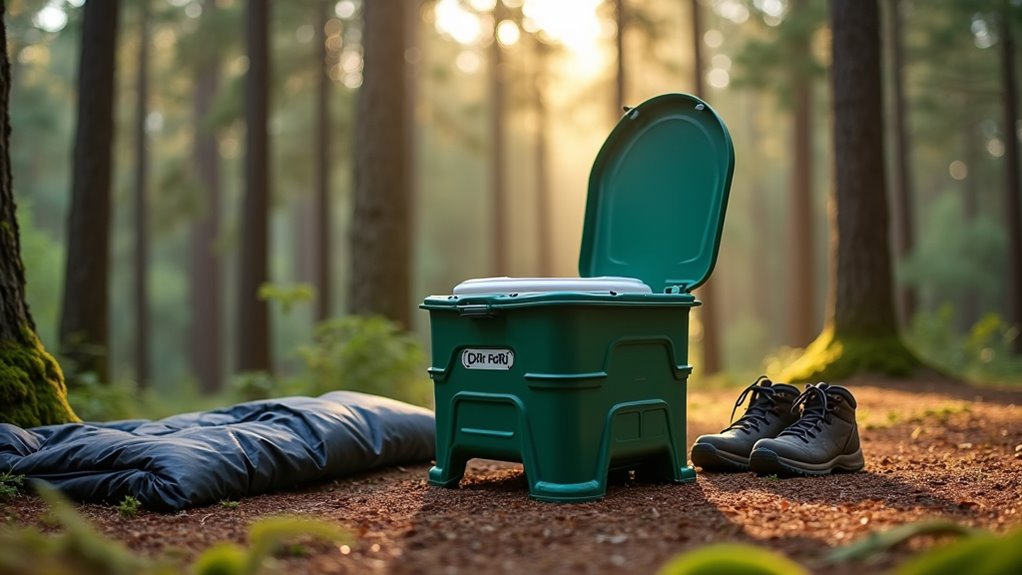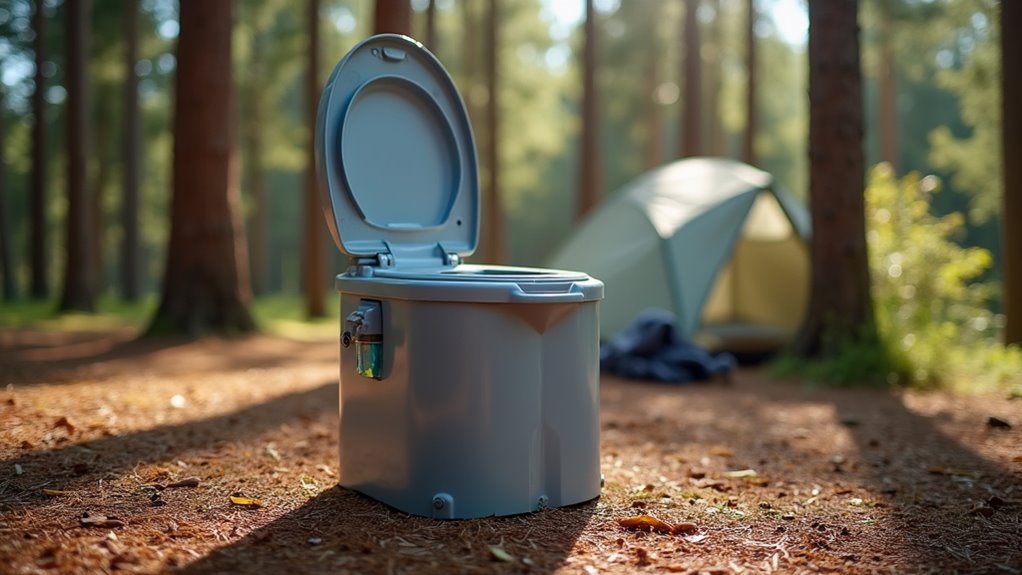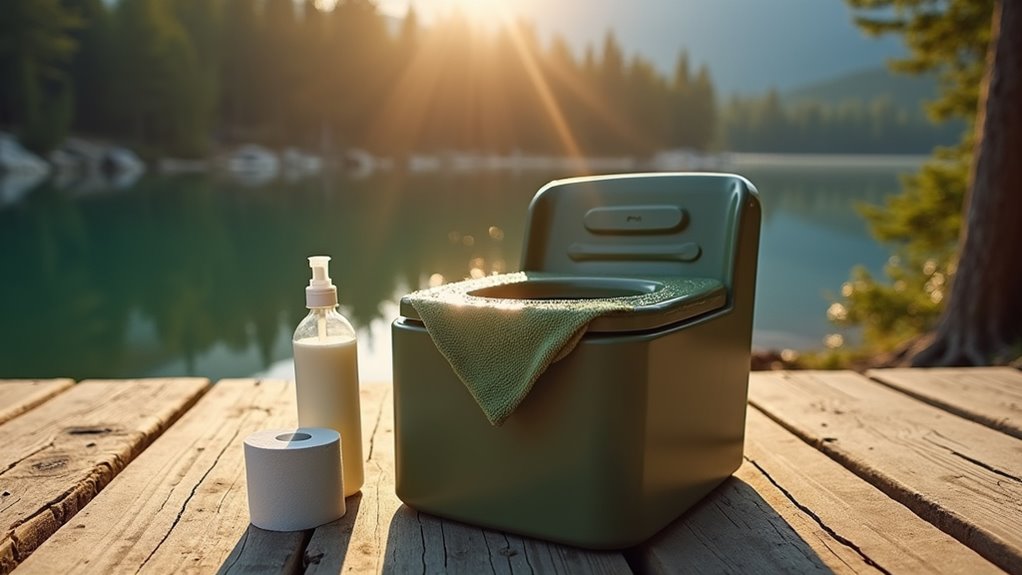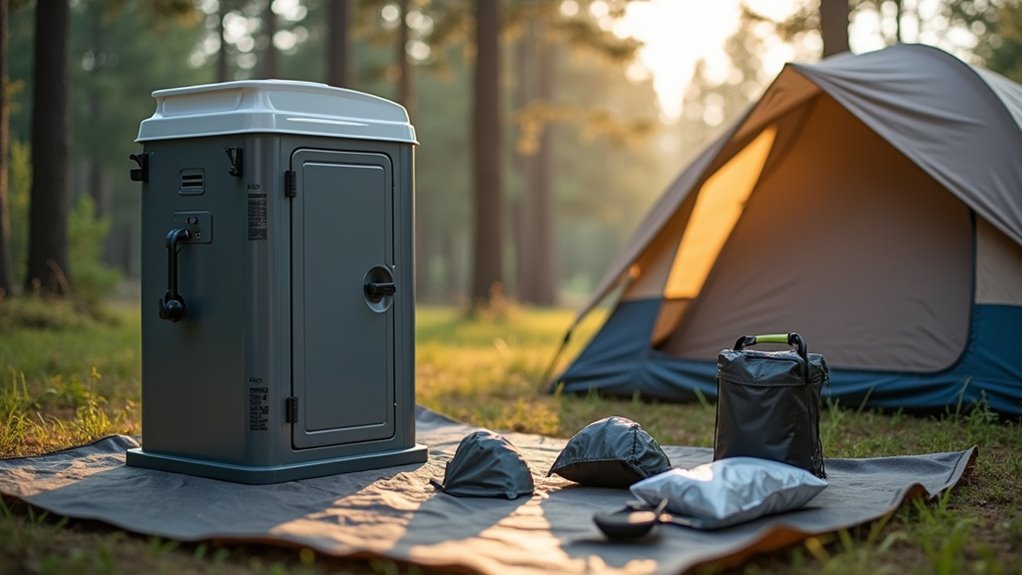Physical Address
304 North Cardinal St.
Dorchester Center, MA 02124
Physical Address
304 North Cardinal St.
Dorchester Center, MA 02124

Discover the surprising truth about camping toilets that will revolutionize your outdoor adventures and solve your biggest wilderness worry.
Think of camping toilets as your portable privacy sanctuary when nature calls in the great outdoors. You’ve probably wondered if these contraptions actually exist beyond the domain of camping folklore, and the answer might surprise you. While you’re planning your next wilderness adventure, you’ll discover that modern portable toilets aren’t just basic bucket setups anymore. They’ve evolved into sophisticated systems that’ll completely change how you approach extended outdoor trips and remote camping experiences.

When you’re miles away from the nearest restroom, camping toilets become your portable solution for nature’s call. These compact units work through different mechanisms depending on their type.
Chemical toilets use special fluids to break down waste and control odors in a sealed tank system. Composting models rely on natural decomposition processes, mixing waste with organic materials like peat moss. Portable flush toilets operate similarly to home toilets, using a freshwater tank and waste holding tank with a manual pump.
Most camping toilets feature a seat, waste compartment, and some form of waste treatment system. You’ll typically need to empty the waste tank periodically and add chemicals or composting materials as needed. They’re designed for easy transport and setup at your campsite. When using outdoor facilities, remember that proper bite management techniques can help protect you from insects that might be attracted to waste areas.
How do you choose the right portable camping toilet when faced with so many options? You’ll find several distinct types, each serving different camping needs.
Bucket toilets are the simplest option—basically a sturdy bucket with a snap-on lid and toilet seat. They’re lightweight and affordable but require frequent emptying.
Bucket toilets deliver basic functionality at the lowest cost but demand more hands-on maintenance than other portable options.
Cassette toilets offer more comfort with a flushable bowl and removable waste tank. You’ll get a home-like experience, though they’re heavier and pricier.
Composting toilets break down waste naturally using peat moss or sawdust. They’re eco-friendly and odor-free but need regular maintenance.
Portable flush toilets combine a freshwater tank with a waste holding tank. They’re comfortable and self-contained, making them perfect for extended trips where convenience matters most.
Many teen camping services across the USA recommend researching portable toilet options before your trip to ensure you have the right setup for your group’s needs.

Two main price tiers define the portable camping toilet market, and your choice between them depends on how often you’ll camp and what comfort level you need.
Budget-friendly options ($20-50) work perfectly for occasional campers. You’ll get basic functionality with simple bucket designs or lightweight portable models. They’re no-frills but effective.
Premium toilets ($80-300) offer enhanced comfort and convenience for frequent outdoor enthusiasts. Here’s what you’re really paying for:
Consider your camping frequency and comfort priorities. Weekend warriors often find budget models sufficient, while serious campers appreciate premium features.
Just like selecting the right camping cookware for your needs, determining how much toilet equipment to bring depends on your trip duration and group size.
Before you pull the trigger on any camping toilet purchase, several key features will make or break your outdoor bathroom experience. First, consider capacity—how many uses can it handle before emptying? You’ll want something that matches your trip length and group size.
Portability matters too. Look for lightweight models with carrying handles if you’re backpacking, or wheeled options for car camping.
Stability is essential—wobbly toilets create uncomfortable situations nobody wants.
Waste containment should be leak-proof and easy to empty. Some models feature detachable waste tanks, while others use disposable bags.
Odor control through sealing mechanisms or chemical treatments keeps things pleasant.
Finally, consider setup complexity. You don’t want to wrestle with complicated assembly when nature calls urgently.
If you’re planning extreme outdoor adventures, remember that even glacier climbing trails require proper waste management planning to preserve pristine wilderness areas.

Now that you know what makes a quality camping toilet, let’s explore the situations where they truly shine. You’ll find these portable solutions invaluable when nature’s call can’t wait for civilization.
Here’s when camping toilets become your best friend:
When nature calls and civilization is nowhere to be found, a quality camping toilet transforms from luxury to absolute necessity.
You’ll appreciate the privacy, convenience, and peace of mind they provide during these challenging outdoor situations. As outdoor enthusiasts continue to seek innovative solutions, camping toilets represent one of the latest trends in essential camping gear that addresses real comfort and hygiene needs.
While having the right camping toilet is important, proper setup and usage will make or break your outdoor bathroom experience. First, choose level ground away from water sources and campsites. Set up your toilet on stable terrain, ensuring it won’t tip over. Most portable toilets require simple assembly – just snap parts together or unfold.
Before first use, add water and toilet chemicals to the waste tank following manufacturer instructions. These chemicals break down waste and control odors.
When using, press the flush pedal gently – don’t overdo it. After each trip, close the toilet seat and waste valve.
Empty the tank when it’s two-thirds full, not completely full. This prevents spills and makes the job easier.
Just like with safe food storage, proper waste management is crucial for maintaining hygiene and preventing contamination of your camping area.

Although camping toilets are built to handle tough outdoor conditions, they’ll last longer and perform better when you maintain them properly. Regular cleaning isn’t just about hygiene—it’s about protecting your investment and ensuring reliable performance trip after trip.
Here’s your essential maintenance routine:
You’ll also want to lubricate seals annually and replace worn parts as needed. Proper maintenance keeps your camping toilet functioning smoothly for years.
When planning your next outdoor adventure, consider activities like Rogue River rafting that combine excitement with the beauty of nature while still having access to proper facilities.
Before you pack your camping toilet for that next adventure, you’ll need to understand the rules governing waste disposal in your chosen destinations. Most national parks and forests require specific waste management practices, often prohibiting dumping gray or black water on the ground. Many campgrounds mandate using designated dump stations for portable toilet waste.
Understanding waste disposal regulations before your camping trip prevents costly fines and protects the environment you came to enjoy.
State parks typically enforce their own regulations, so check local rules before arriving. Some backcountry areas require pack-out systems, meaning you’ll carry all waste with you.
Private campgrounds usually provide dump facilities but may charge fees for non-guests.
Always verify regulations online or call ahead. Violating waste disposal laws can result in hefty fines and environmental damage citations. When in doubt, pack it out.
Just like deciding whether to rent or buy a boat for fishing trips, choosing the right portable toilet involves weighing short-term versus long-term costs based on your camping frequency.

If you’re hesitant about investing in a traditional camping toilet or need lighter-weight options for backpacking, several alternatives can meet your outdoor sanitation needs.
Portable Solutions That Work:
You’ll find these alternatives particularly useful for dispersed camping where facilities don’t exist. Wag bags work best in desert environments or alpine zones where digging isn’t feasible.
Pack extra toilet paper in waterproof bags, and always follow local regulations about waste disposal methods. The share economy offers rental platforms where you can borrow camping sanitation equipment from other outdoor enthusiasts before purchasing your own gear.
You’ll find camping toilets aren’t just real—they’re game-changers for outdoor adventures. Consider Sarah, who spent three miserable days at a remote campsite last summer, hiking half a mile to questionable facilities at 2 AM. Now she swears by her portable cassette toilet, sleeping soundly knowing relief’s just steps away. Don’t let bathroom anxiety ruin your next trip. Invest in a quality camping toilet and transform your outdoor experience from stressful to spectacular.